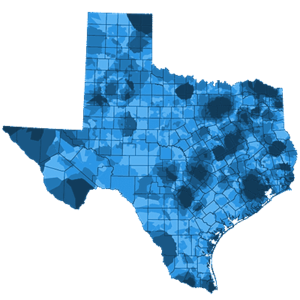The Problem
Unfortunately, Texas is losing her rural lands at an alarming rate to development and fragmentation, which can lead to increased erosion, sedimentation in rivers and reservoirs, polluted runoff, limited aquifer recharge, and added pressure on municipalities and water districts to invest in costly water treatment and collection infrastructure. The conservation of Texas’ private working lands is one of the most immediate and cost-effective ways to ensure a future of abundant, clean water for ALL Texans.
Imagine a life with no water.
A critical natural resource, water impacts every facet of life. The health of our rural lands, which capture, store and clean water, affects the health of our water resources. If we don’t act now to conserve these lands, providing affordable clean water for our citizens will be a challenge in the future.
LAND: The source of our water
“Saving the water and the soil must start where the first raindrop falls.”
– President Lyndon B. Johnson, 1947
The water that comes out of a tap in Houston or Dallas most likely starts as a raindrop on a farm or ranch. The conservation of Texas’ private working lands is an immediate and cost-effective way to help ensure a future of abundant, clean water for all Texans.
97% of Texas’ lands are privately owned; farms and ranches make up 84% of those lands. How these lands are managed impacts water quality and quantity. With proper stewardship, these lands capture and clean the water that recharges our aquifers and fills the rivers and reservoirs which supply our drinking water.
Land: The missing link from the state’s water plan.
Texas leads the country in planning for future water demands. A collaborative process involving 16 regional planning groups approves strategies, such as reservoirs and desalinization plants, to ensure adequate water to support our cities, industries, and farms and ranches.
Missing from the plan, however, are strategies to conserve the land where the rain falls. Missing are projects that protect the rural lands that capture and clean the rain that comes out in taps in our cities.
In his keynote address to the Texas Wildlife Association’s annual conference in July 2016, Texas House Speaker Joe Straus commented,
“…providing water is not all about pipes and pumps. It’s also about protecting our aquifers and rivers, and we need private stewardship to do so. Almost every drop of water in this state falls first on private property.”
Why Should I Care?
Increased Demand & Population by 2070

By 2070, Texas’ population will grow by 70 percent to 50+ million people.
To help ensure sufficient water supplies for these future populations, we need to ACT TODAY to protect the lands that capture and clean the water that goes into those pipes and pumps provided for by the state’s water plan. Learn more about the solution.
Texas’ existing water supplies— those that can already be relied upon in the event of drought— are expected to decline by approximately 11 percent between 2020 and 2070, from 15.2 million to 13.6 million acre-feet per year.
What are the consequences if we do nothing to protect the land where the rain falls? How will water scarcity impact you?

